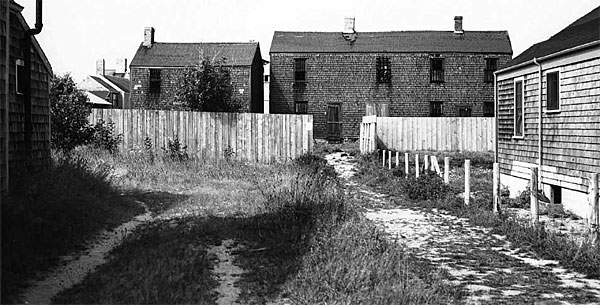by Frances Karttunen
On the left side of Orange Street as one proceeds outbound toward the edge of town stands the Landmark House. Now housing an assisted living community, it was previously Our Island Home.

Before the prominent old building was Our Island Home, it had been Nantucket’s Town and County Asylum. The word “asylum” invites the modifier “insane,” but Nantucket’s Asylum served the indigent. A person might be unable to support himself by reason of mental incapacity, but some elderly people found their way to the Asylum simply because they had outlived anyone who could care for them at home. Others ended up there after falling ill in a faraway place. Such was the plight of at least two unfortunate Pacific Islanders who came to Nantucket on whaling ships and breathed their last in Nantucket’s Asylum.
The Orange Street building was not built where it now stands. Like so many historic Nantucket houses, it has led a peripatetic life. It actually began its service far out of town in Quaise as part of an evolving social experiment. In 1773 the Town of Nantucket had built a workhouse on land between Vestal Street and Upper Main Street. Initially, residence there was not compulsory for people receiving municipal aid, but then things changed. Nantucket historian Obed Macy wrote, “Somewhere about 1796 it was concluded that all who wanted supplies from the town must come and reside at the socalled workhouse. By midwinter this plan came near to starving some of the
poor to death, for rather than take their families and go to the workhouse, they went hungry.” In 1805 the town built a jail on the site of the old workhouse, necessitating some other living arrangement for the indigent.
It took until 1822 for the town to come up with a solution. The poor would be moved to a healthful rural setting where they would raise their own food. According to the town’s selectmen, Mark Coffin had a farm in Quaise that just fit the bill. Obed Macy did not approve of this plan. He objected that the move would isolate the poor from the community and their relatives, that transporting people
and supplies out there would be expensive, and that the people who would be sent to Quaise were too debilitated to do farm work. At the very least, wrote Macy, the town should consider buying one of several smaller farms that were available at the time.
The town meeting ignored these considerations and went ahead with the plan. Coffin’s farm was purchased and four buildings were erected on it. Ultimately, one of them—built in 1826—was moved to town and re-erected right next to the jail off Vestal Street to serve as Nantucket’s House of Correction.
The Quaise Asylum functioned from the 1820s to 1844 when a fire broke out on a snow-bound winter night. The alarm bell was tolled and tolled, but the fire had burned itself out before firefighters could make their way to Quaise. Of the fifty-nine inmates of the Asylum, ten perished in the blaze. The dead ranged in age from 41 to 87 years old.
The dead were buried in an unmarked plot that lies on the south side of Polpis Road, and the next year the town invested nearly $2,000 in a fine new building for the Quaise Asylum. Nonetheless, Obed Macy’s predictions had proven true. Isolating the poor had proven fatal for ten of them, and provisioning the survivors so far from town was impractical. In less than a decade the new building was moved in sections from Quaise to the present location on Orange Street to serve as a place “for care of the needy, mentally ill, homeless, and diseased.” The residents were still expected to raise their own vegetables, and they did so on the nearby land known to this day as Poverty Point. The 1854 move cost the town $7,500. Hardly had the facility gotten up and running on Orange Street when two significant deaths took place there: on November 24, 1854, Abram Quary, “the First
that died in the Asylum in Town, aged 82 years, 10 months;” and then on January 12, 1855, Dorcas Honorable, “Aged 72 years, 8 months, 12 days.” They were the very last of Nantucket’s dwindling list of “last Indians.”
In 1873 Patience Cooper, a woman who—by modern standards of evidence— should never have been convicted of manslaughter in the 1860s, was released after two years in the Dickensian Bristol Country House of Correction. Prior to that she had spent a decade in the House of Corrections on Vestal Street, the old building originally built in 1826 at the Quaise Farm. At the time of her release, Cooper was an aged and debilitated woman with nowhere to go, so she became a resident of the Asylum on Orange Street. After an interval of two years of incarceration offisland, she had exchanged life in one recycled Quaise Farm building for life in another. There she lived until her death in 1885.
The community’s attitude toward those who were unable to live on their own continued to evolve. Obed Macy observed that the “town poor” had been miserably provided for back in the 1790s. At the beginning of the 1820s, as the town meeting debated moving them out of town, Macy wrote, “It is represented that they are nasty and wicked.” By the time the Asylum was brought back to town, attitudes had softened a bit. Now the Asylum existed to provide care for the incapacitated.
Finally, in 1905, the town’s board of overseers renamed the Asylum “Our Island Home” and defined its mission as to provide “tender loving care of the infirm aged,” a role fulfilled with grace and real beauty to this day.
After the nursing home residents moved into their new building in 1981 and took the name Our Island Home with them, a five-year effort to transform the old Asylum building into affordable housing for Nantucket’s independent seniors came to fruition, and the Landmark House opened. So ended the odyssey of a building that began its existence miles away as part of a punitive institution.
And what about the other old Asylum building that was moved to town to serve a decidedly more punitive function—as the Town and County House of Correction next to the jail off Vestal Street? In 1952 it was declared a fire hazard and demolished.
Frances Karttunen’s books: The Other Islanders: People Who Pulled Nantucket’s Oar, her Nantucket Places & People series, Good Things from Nantucket’s North Shore, and Law and Disorder in Old Nantucket, are available at Nantucket bookstores.


